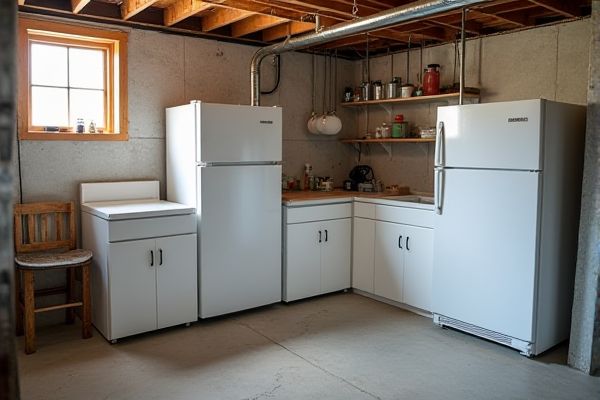
Choosing between an upright freezer and a chest freezer for your basement depends on space availability, energy efficiency, and ease of access; upright freezers offer better organization with shelves and a smaller footprint, while chest freezers generally provide more storage capacity and better temperature retention. Discover which freezer best suits your storage needs and basement setup by reading the full article.
Table of Comparison
| Feature | Upright Freezer | Chest Freezer |
|---|---|---|
| Space Efficiency | Vertical storage, smaller footprint | Larger footprint, uses basement floor space |
| Storage Capacity | Less volume, organized shelves | More volume, bulk storage |
| Energy Consumption | Higher energy use | More energy efficient |
| Temperature Stability | Moderate, more warm air exposure when opened | Better temperature retention |
| Ease of Access | Easier vertical access, adjustable shelves | Requires bending, less organized |
| Basement Suitability | Good for limited floor space | Ideal for large basement areas |
| Defrosting | Often frost-free models | Manual defrost common |
| Price Range | Moderate to high | Typically lower cost |
Introduction to Upright vs Chest Freezers for Basements
Upright freezers offer easy access to stored items with organized shelves, making them ideal for tight basement spaces where vertical storage is a priority. Chest freezers provide greater storage capacity and energy efficiency, well-suited for bulk storage in larger basement areas. Your choice depends on space availability and how frequently you access frozen goods.
Key Differences: Upright and Chest Freezer Designs
Upright freezers offer vertical storage with multiple shelves and door compartments, making organization and access easier in a confined basement space. Chest freezers provide a larger, open interior ideal for bulk storage, using a top-opening lid that conserves energy by limiting cold air loss. Your choice depends on whether you prioritize space efficiency and ease of access or maximum storage capacity and energy efficiency in your basement.
Space and Layout Considerations for Basements
Upright freezers optimize vertical space in basements with limited floor area, allowing for easier access to items without bending. Chest freezers require more floor space but offer superior insulation and energy efficiency, making them ideal for cooler basement environments. Careful measurement of basement layout and available clearance is essential to ensure proper airflow and ease of use for either freezer type.
Storage Capacity: Upright Freezer vs Chest Freezer
Chest freezers typically offer greater storage capacity compared to upright freezers, making them ideal for bulk storage in basement settings. Upright freezers provide easier organization with multiple shelves and compartments, enhancing accessibility despite generally smaller overall capacity. Choosing between the two depends on balancing the need for space efficiency and user-friendly storage in the basement environment.
Accessibility and Organization Features
Upright freezers offer superior accessibility with multiple shelves and door bins, enabling easier organization and quick retrieval of items in a basement setting. Chest freezers provide greater storage capacity but require bending and digging through items, which can hinder organization and access in confined basement spaces. Choosing an upright freezer enhances visibility and management of frozen goods, especially when space optimization and frequent access matter most.
Energy Efficiency and Power Consumption
Upright freezers typically consume more energy than chest freezers due to their design, which causes cold air to escape more easily when the door is opened. Chest freezers offer superior insulation and maintain lower temperatures more efficiently, reducing power consumption in your basement. Your choice between the two will impact energy bills, with chest freezers generally providing greater energy efficiency for long-term storage.
Temperature Performance in Basement Environments
Upright freezers in basement environments often provide more consistent temperature control due to better air circulation and temperature stability, which is crucial in fluctuating basement conditions. Chest freezers excel in maintaining lower temperatures during power outages because of their insulated lids and compartment design that minimizes cold air loss. Both freezer types perform effectively in basements, but chest freezers typically offer superior temperature retention and energy efficiency for long-term storage.
Maintenance, Cleaning, and Defrosting
Upright freezers generally require less floor space and feature automatic defrosting systems, reducing the maintenance effort, while chest freezers often need manual defrosting to prevent ice build-up, which can be more time-consuming. Cleaning a chest freezer is simpler due to its wide opening and removable baskets, allowing easier access to all corners, whereas upright freezers' narrow shelves and compartments can make thorough cleaning more challenging. Your choice depends on the convenience you want for routine maintenance and defrosting in your basement setup.
Cost Comparison and Long-term Value
Upright freezers typically have a higher initial cost but offer better space efficiency and easier organization, making them ideal for smaller basement areas. Chest freezers generally cost less upfront and provide better energy efficiency, resulting in lower operating expenses over time. Long-term value depends on usage patterns; chest freezers often preserve food longer with less energy consumption, while upright models offer convenience and improved accessibility.
Choosing the Best Freezer for Your Basement Needs
When selecting a freezer for your basement, consider space availability and ease of access; upright freezers offer vertical storage with organized shelves, ideal for narrow spaces, while chest freezers provide greater capacity and energy efficiency, making them perfect for bulk storage. Temperature stability and insulation quality are crucial in basement environments to prevent moisture buildup and maintain food quality. Your decision should balance convenience with storage volume to optimize your basement's cooling efficiency and usability.
 homyna.com
homyna.com